 Buick Enclave: Lower Anchors and Tethers for Children (LATCH System)
Buick Enclave: Lower Anchors and Tethers for Children (LATCH System)
The LATCH system holds a child restraint during driving or in a crash.
This system is designed to make installation of a child restraint easier.
The LATCH system uses anchors in the vehicle and attachments on the child restraint that are made for use with the LATCH system.
Make sure that a LATCH-compatible child restraint is properly installed using the anchors, or use the vehicle's safety belts to secure the restraint, following the instructions that came with that restraint, and also the instructions in this manual.
When installing a child restraint with a top tether, you must also use either the lower anchors or the safety belts to properly secure the child restraint. A child restraint must never be attached using only the top tether and anchor.
In order to use the LATCH system in your vehicle, you need a child restraint that has LATCH attachments. The child restraint manufacturer will provide you with instructions on how to use the child restraint and its attachments.
The following explains how to attach a child restraint with these attachments in your vehicle.
Not all vehicle seating positions or child restraints have lower anchors and attachments or top tether anchors and attachments.
Lower Anchors
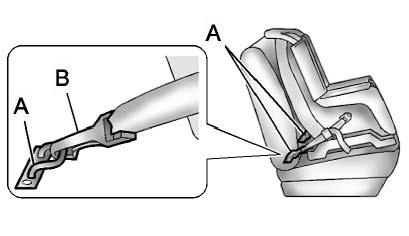
Lower anchors (A) are metal bars built into the vehicle.
There are two lower anchors for each LATCH seating position that will accommodate a child restraint with lower attachments (B).
Top Tether Anchor

Your child restraint may have a single tether (A) or a dual tether (C). Either will have a single attachment (B) to secure the top tether to the anchor.
Some child restraints with top tethers are designed for use with or without the top tether being attached. Others require the top tether always to be attached.
In Canada, the law requires that forward-facing child restraints have a top tether, and that the tether be attached. Be sure to read and follow the instructions for your child restraint.
Lower Anchor and Top Tether Anchor Locations

Second Row — Bucket
 (Top Tether Anchor): Seating positions
with top tether anchors.
(Top Tether Anchor): Seating positions
with top tether anchors.
 (Lower Anchor): Seating positions
with two lower anchors.
(Lower Anchor): Seating positions
with two lower anchors.

Second Row — 60/40 Bench
 (Top Tether Anchor): Seating positions
with top tether anchors.
(Top Tether Anchor): Seating positions
with top tether anchors.
 (Lower Anchor): Seating positions
with two lower anchors.
(Lower Anchor): Seating positions
with two lower anchors.

Third Row
 (Top Tether Anchor): Seating positions
with top tether anchors.
(Top Tether Anchor): Seating positions
with top tether anchors.

To assist you in locating the lower anchors, each second row anchor position has a label, near the crease between the seatback and the seat cushion.

To assist you in locating the top tether anchors, the top tether anchor symbol is located on the cover, if equipped, or near the anchor.
The top tether anchors are located at the bottom rear of the seatback for each seating position in the second row.

Second Row — Bucket Shown, Bench Similar
Some vehicles have top tether anchors with a cover. Open the cover to access the anchors.
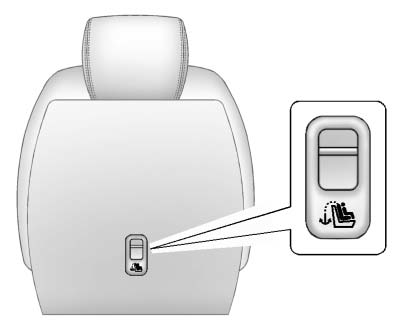
Second Row — Bucket Shown, Bench Similar
Some vehicles have exposed top tether anchors.
Be sure to use an anchor located on the same side of the vehicle as the seating position where the child restraint will be placed.
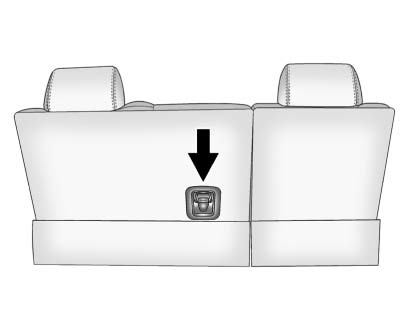
Third Row
The third row has one top tether anchor located at the bottom rear of the center seatback. This anchor should be used for the center seating position only. Never install two top tethers using the same top tether anchor.
Do not secure a child restraint in a position without a top tether anchor if a national or local law requires that the top tether be attached, or if the instructions that come with the child restraint say that the top tether must be attached.
According to accident statistics, children and infants are safer when properly restrained in a child restraint system or infant restraint system secured in a rear seating position. See Where to Put the Restraint for additional information.
Securing a Child Restraint Designed for the LATCH System
 WARNING
WARNING
If a LATCH-type child restraint is not attached to anchors, the child restraint
will not be able to protect the child correctly. In a crash, the child could be
seriously injured or killed. Install a LATCH-type child restraint properly using
the anchors, or use the vehicle safety belts to secure the restraint, following
the instructions that came with the child restraint and the instructions in this
manual.
 WARNING
WARNING
Do not attach more than one child restraint to a single anchor.
Attaching more than one child restraint to a single anchor could cause the anchor or attachment to come loose or even break during a crash. A child or others could be injured. To reduce the risk of serious or fatal injuries during a crash, attach only one child restraint per anchor.
 WARNING
WARNING
Children can be seriously injured or strangled if a shoulder belt is wrapped
around their neck and the safety belt continues to tighten. Buckle any unused safety
belts behind the child restraint so children cannot reach them.
Pull the shoulder belt all the way out of the retractor to set the lock, if the vehicle has one, after the child restraint has been installed.
Notice: Do not let the LATCH attachments rub against the vehicle’s safety belts. This may damage these parts. If necessary, move buckled safety belts to avoid rubbing the LATCH attachments.
Do not fold the empty rear seat with a safety belt buckled.
This could damage the safety belt or the seat. Unbuckle and return the safety belt to its stowed position, before folding the seat.
1. Attach and tighten the lower attachments to the lower anchors. If the child restraint does not have lower attachments or the desired seating position does not have lower anchors, secure the child restraint with the top tether and the safety belts. Refer to your child restraint manufacturer instructions and the instructions in this manual.
1.1. Find the lower anchors for the desired seating position.
1.2. Recline the seatback to the full reclined position.
Make sure the second row bench seatbacks are aligned at the same angle before placing the child restraint on the seat. Make sure the third row bench seatbacks are both upright before placing the child restraint on the seat.
1.3. Put the child restraint on the seat.
1.4. Attach and tighten the lower attachments on the child restraint to the lower
anchors.
2. If the child restraint manufacturer recommends that the top tether be attached, attach and tighten the top tether to the top tether anchor, if the vehicle has one.
Refer to the child restraint instructions and the following steps:
2.1. Find the top tether anchor.
2.2. If the anchor is covered, flip open the cover to expose the anchor.
2.3. Route, attach, and tighten the top tether according to your child restraint
instructions and the following instructions:
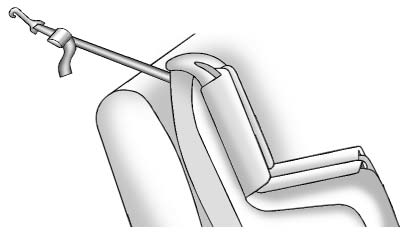
If the position you are using does not have a headrest or head restraint and you are using a single tether, route the tether over the seatback.
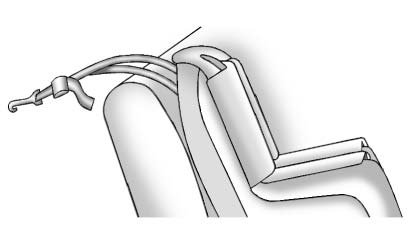
If the position you are using does not have a headrest or head restraint and you are using a dual tether, route the tether over the seatback.
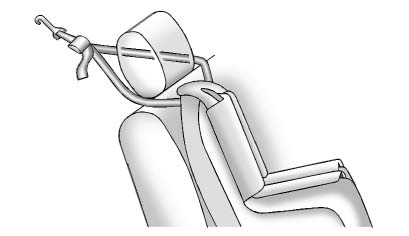
If the position you are using has a fixed headrest or head restraint and you are using a dual tether, route the tether around the headrest or head restraint.
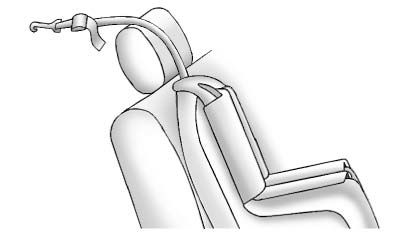
If the position you are using has a fixed headrest or head restraint and you are using a single tether, route the tether over the headrest or head restraint.
3. Before placing a child in the child restraint, make sure it is securely held in place. To check, grasp the child restraint at the LATCH path and attempt to move it side to side and back and forth. There should be no more than 2.5 cm (1 in) of movement, for proper installation.
 Where to Put the Restraint
Where to Put the Restraint
According to accident statistics, children and infants are safer when properly
restrained in a child restraint system or infant restraint system secured in a rear
seating position.
We recommend t ...
 Replacing LATCH System Parts After a Crash
Replacing LATCH System Parts After a Crash
WARNING
A crash can damage the LATCH system in the vehicle.
► damaged LATCH system may not properly secure the child restraint, resulting in
serious injury or even death in a crash.
To help ...
See also:
Towing load/specification
1: The towing capacity values are calculated assuming a base vehicle with
driver and
any options required to achieve the rating. Additional passengers, cargo and/or
optional equipment will add ...
Deselecting valet mode
When you enter the vehicle, touch the Valet button to view the Valet mode screen.
Enter your 4 digit PIN and touch the OK button. Valet mode deactivated is displayed
to indicate that your PIN has ...
Search area
The navigation map database is divided into countries, or geographically defined
areas within countries, that the navigation system recognises as search areas. When
setting a route, the destinatio ...






